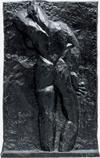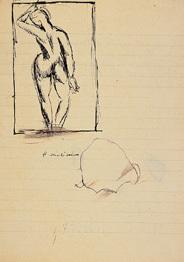

Back (II) in bronze, 1911–13. The Museum of Modern Art, New York, Mrs. Simon Guggenheim Fund, 1956.

Three-dimensional digital model,
Back (II).
Back (II), 1911 (?)–early March or April 1913
Matisse began Back (II) from a new plaster cast of Back (I), which he both reduced by carving and built up with new plaster as he worked to make a more angular and massive form. While he added to the bulk, he removed details from the head, hair, neck, and shoulders. Focused on transforming the style of the figure, he removed the curving, S-shaped spine and soft flesh to produce an increasingly solid, stocky body with a more geometric build.

Backs and Scene of Tangier, 1912/13. Pen and reed and ink on paper. Private collection.
The exaggerated modeling on the figures in this sheet suggests the dramatic effect of highlights and shadows that Matisse witnessed in the light of Morocco and indicates that he continued to think about his bas-relief during his travels. The hatched shading employed on the body of the right figure emphasizes areas of added volume and chiseled form seen in Back (II).

Study for the Back (II), c. 1913. Ink on lined paper. The Museum of Modern Art, New York, gift of Pierre Matisse, 1971.
Matisse chiseled down the surface in the upper-right corner of Back (II), leaving prominent, repeated marks that fan out and up from the right side. This area also recalls the hatched patterns he used to describe volumes in a related study of the sculpture. We can see traces of these elsewhere on Back (II), where he adjusted the figure’s form.




